
LayerZero is a trustless omnichain interoperability protocol designed to address the issues of liquidity fragmentation in the blockchain industry as a whole. This is achieved with a lightweight message-passing protocol that provides authentic and guaranteed delivery.

The core concept of LayerZero revolves around its user application (UA) configurable on-chain endpoint, which is responsible for running the User Level Network (ULN). LayerZero utilizes two key parties, the Oracle and the Relayer, to facilitate the transfer of messages between on-chain endpoints.
When a UA wants to send a message from chain A to chain B, the message is first routed through the endpoint on chain A. The endpoint then notifies the specified Oracle and Relayer about the message and its intended destination chain.
The Oracle, upon receiving the notification, fetches the block header from chain A and forwards it to the endpoint on chain B. Simultaneously, the Relayer retrieves the transaction proof associated with the message and submits it.
On the destination chain, the received block header and transaction proof are validated to ensure their authenticity and correctness. If the validation is successful, the message is then forwarded to the specified destination address, completing the transfer of the message from chain A to chain B.
With the proliferation of blockchains, users have been constrained by the isolation of each chain. This leads to fragmented liquidity and limited options for moving liquidity and state between different ecosystems. LayerZero aims to provide a powerful low-level communication primitive that enables the development of cross-chain applications without the need for trusted intermediaries or custodians.
LayerZero operates at the communication primitive level, facilitating diverse omnichain applications. While exchanges are one example of applications that can benefit from LayerZero, the protocol itself focuses on enabling seamless inter-chain transactions and communication. By offering trustless messaging capabilities between Layer 1 and Layer 2 chains, LayerZero establishes itself as the first trustless omnichain interoperability layer.

To tackle the issue of liquidity fragmentation across chains, LayerZero introduces a powerful low-level communication primitive that enables the development of a wide range of cross-chain applications without the need for trusted intermediaries or custodians. Unlike existing solutions such as decentralized exchanges (DEXs), LayerZero eliminates the trust problem associated with cross-chain transactions.
Traditional DEX implementations require users to convert their tokens into protocol-specific tokens and rely on an intermediate consensus layer to achieve transaction consensus. However, this introduces unnecessary overhead and reliance on side chains, compromising the core tenets of trustlessness in blockchain technology.
LayerZero revolutionizes the concept of trustless cross-chain transactions. Its communication protocol, called “valid delivery,” ensures that a transaction is delivered only when it is committed and valid on the sender chain, providing security guarantees. By combining independent entities—an Oracle providing block headers and a Relayer providing transaction proofs—LayerZero establishes a direct and secure communication channel between sender and recipient chains.
Operating through lightweight on-chain clients known as LayerZero Endpoints, the protocol enables direct cross-chain transactions between any chains that have implemented LayerZero. This creates a fully connected network where nodes on different chains can establish direct connections, facilitating seamless interaction and liquidity movement across chains.
LayerZero’s trustless approach to interoperability opens up new possibilities for large-scale applications, including cross-chain decentralized exchanges, multi-chain yield aggregators, and cross-chain lending. With LayerZero, users can consolidate liquidity, participate in decentralized finance (DeFi) applications, and access diverse ecosystems without relying on intermediaries or resorting to intermediate tokens.
To ensure trustless inter-chain communication and validate transactions on different chains, LayerZero introduces the concept of valid delivery. Valid delivery serves as a communication primitive that enables cross-chain token transfers while providing specific guarantees:
While existing exchanges and DEXs enable cross-chain token transfers, they introduce unnecessary complexity and costs, hindering the broad adoption of cross-chain applications. LayerZero seeks to overcome these limitations by providing a single trustless valid delivery mechanism without the need for a trusted intermediary. In their work, the LayerZero team implements a generic messaging protocol that ensures the trustless valid delivery of various user data, including tokens. This messaging primitive serves as a foundation for distributed exchanges and other decentralized finance (DeFi) applications, empowering them to facilitate cross-chain transactions. The flexibility provided by LayerZero’s low-level messaging protocol allows for the implementation of a wide range of previously unachievable functionalities in higher-level applications.
The core of LayerZero is its communication protocol enabling trustless valid delivery. The protocol incorporates several components to design a cost-effective smart contract-based light client endpoint.
LayerZero Endpoints serve as the user-facing interface to LayerZero, enabling users to interact with the protocol. Each chain in the LayerZero network features a LayerZero Endpoint, implemented as a set of on-chain smart contracts. The primary purpose of a LayerZero Endpoint is to facilitate message transmission using the protocol backend, ensuring trustless valid delivery.
A LayerZero Endpoint comprises four modules: Communicator, Validator, Network, and Libraries. The core functionality of the Endpoint is primarily encapsulated within the Communicator, Validator, and Network modules. Additional Libraries are added for each new chain supported by LayerZero, allowing for seamless integration without modifications to the core modules.
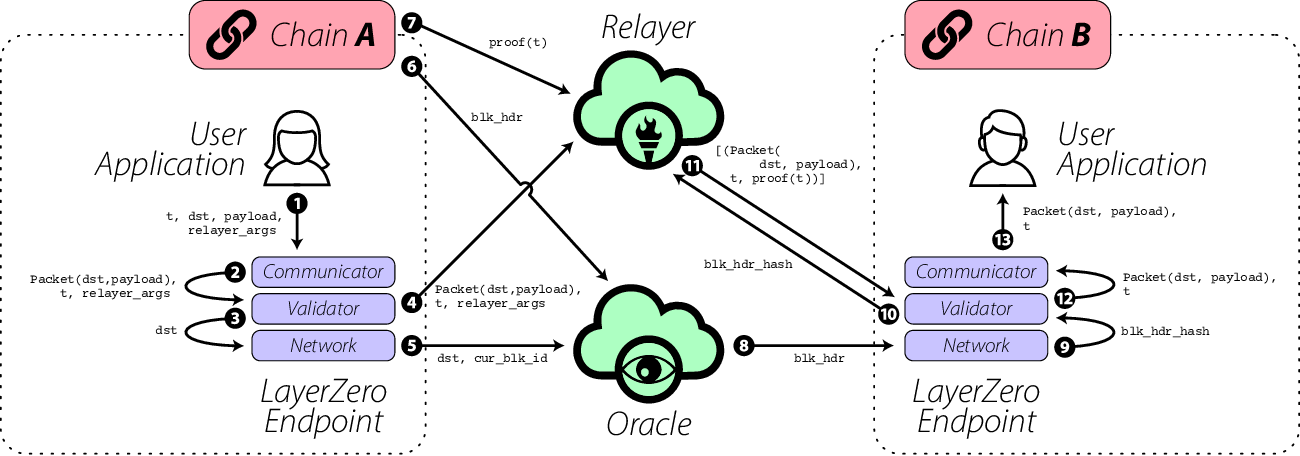
To enable inter-chain communication and support the LayerZero protocol, an Oracle service is utilized. The Oracle, an independent third-party service, reads a block header from one chain and transmits it to another chain. While any third-party service capable of providing this functionality could serve as the Oracle, the current industry leader for decentralized oracle networks, Chainlink, is expected to be utilized in practice for most implementations. On the other hand, the Relayer, functioning as an off-chain service, retrieves the proof for a specified transaction rather than block headers.
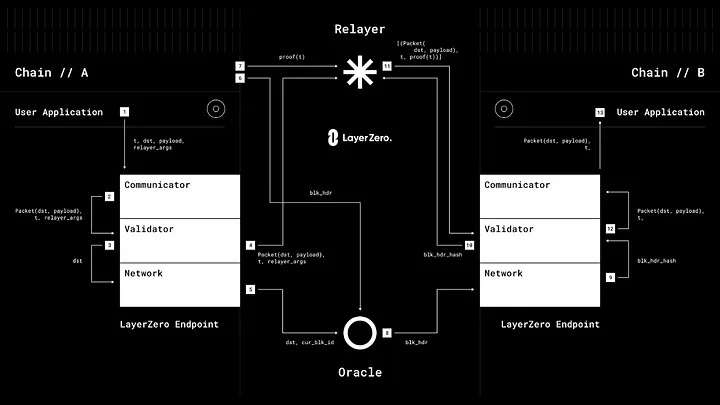
To ensure trustless valid delivery, it is crucial that the Oracle and Relayer are independent of each other for any given message sent via the LayerZero protocol. The protocol itself does not impose specific Relayer implementation requirements, allowing users of LayerZero to even implement their own Relayer service if desired. This design ensures that the Relayer and Oracle cannot collide.
Relayers work together with Oracles to transmit messages between chains. By default, UAs will utilize LayerZero Relayer, and users do not have to run their own Relayer. A customer Relayer requires setting up a custom UA configuration.
Scope of Work
Relay proof across chains, and pay the cost for lzReceive execution.
Gas Composition
The receiving side smart contract overhead + proof cost + lzReceive. Plus, the gas varies from chain to chain.
lzReceive we will have a default configuration per chain.
| Chain | Overhead | Max Proof Cost (Estimate) | default lzReceive |
| Ethereum | – | 240303 | – |
| Avalanche | – | 265574 | – |
| BSC | – | 283471 | – |
| Polygon | – | 341630 | – |
| Arbitrum | – | 173074 | – |
| Optimism | – | N/A | – |
| Fantom | – | Need Valid RPC | – |
Market Risk
Charging native token A at the source chain, but paying native token B at the destination chain.
The business itself is long A / short B, can hedge the market risk with short A / long B in exchanges, or balance the book timely.
To run your own Relayer, follow these high-level requirements for each chain:
User Applications that opt into the default configuration will use the LayerZero Labs Relayer.
LayerZero Labs runs and maintains a Relayer as a production asset for the ecosystem.
Gas Convention
The LayerZero Relayer assumes only a base gas for destination contract calls, e.g. 200k gas for a call on Ethereum. It will only be enough for very simple applications.
If your app requires more gas, please use the adapter parameters specified here.
Take a look at this link for in-depth details.
By default, UAs opt into the LayerZero Protocol library updates. These updates generally bring improvements and changes to the reliability of the protocol’s generic messaging.
These libraries are append-only, meaning that previous versions will always be available for UAs that decide to not use the default config.
For UAs that want to fully control or lock their Oracle properties, see UA Custom Configuration to learn more.
Locking UA configuration guarantees that only UA owners can change their LZ app configs; UAs that opt-in to LayerZero defaults accept LayerZero’s future changes to default configurations (i.e. best practice changes to block confirmations & proof libraries etc.)
Projects with custom configuration will not have any impact on their settings but are free to reconfigure settings back to Defaults or to any other Oracle at any given time.
Performing the job of an Oracle means moving a piece of the message data from one chain and storing it in another.
Two of the primary requirements for operating an Oracle (per chain):
Users wishing to find out more about developing an Oracle should refer to the Oracle Section of the Documentation.
The Google Oracle, as of 9/19/23, is the default Oracle configuration for LayerZero messaging.
For the full list of mainnet addresses, see this list.
For the full list of TSS addresses, see this list.
For the full list of Chainlink addresses, see this list.
These Chainlink nodes provide support and redundancy for the Chainlink Oracle.
Polyhedra Network is building the next generation of infrastructure for Web3 interoperability by leveraging advanced zero-knowledge proof (ZKP) technology, a fundamental cryptographic primitive that guarantees the validity of data and computations while maintaining data confidentiality. The Polyhedra Network team designed and developed Polyhedra zkLightClient technology, a cutting-edge solution built on LayerZero Protocol, providing secure and efficient cross-chain infrastructures for Layer-1 and Layer-2 interoperability.
zkLightClient on LayerZero
LayerZero is a protocol facilitating omnichain interoperability and cross-chain messaging. It empowers dApps developed using blockchain technology to seamlessly connect with over 30 supported blockchains. By leveraging the LayerZero protocol, dApp users can securely and efficiently interact with assets across different chains.
Additionally, Polyhedra’s zkLightClient technology is seamlessly integrated with LayerZero’s messaging protocol, enabling application developers to effortlessly utilize zero-knowledge-proof technology. With LayerZero’s comprehensive developer tools and strong community support, developers can easily create cross-chain applications on top of the protocol.
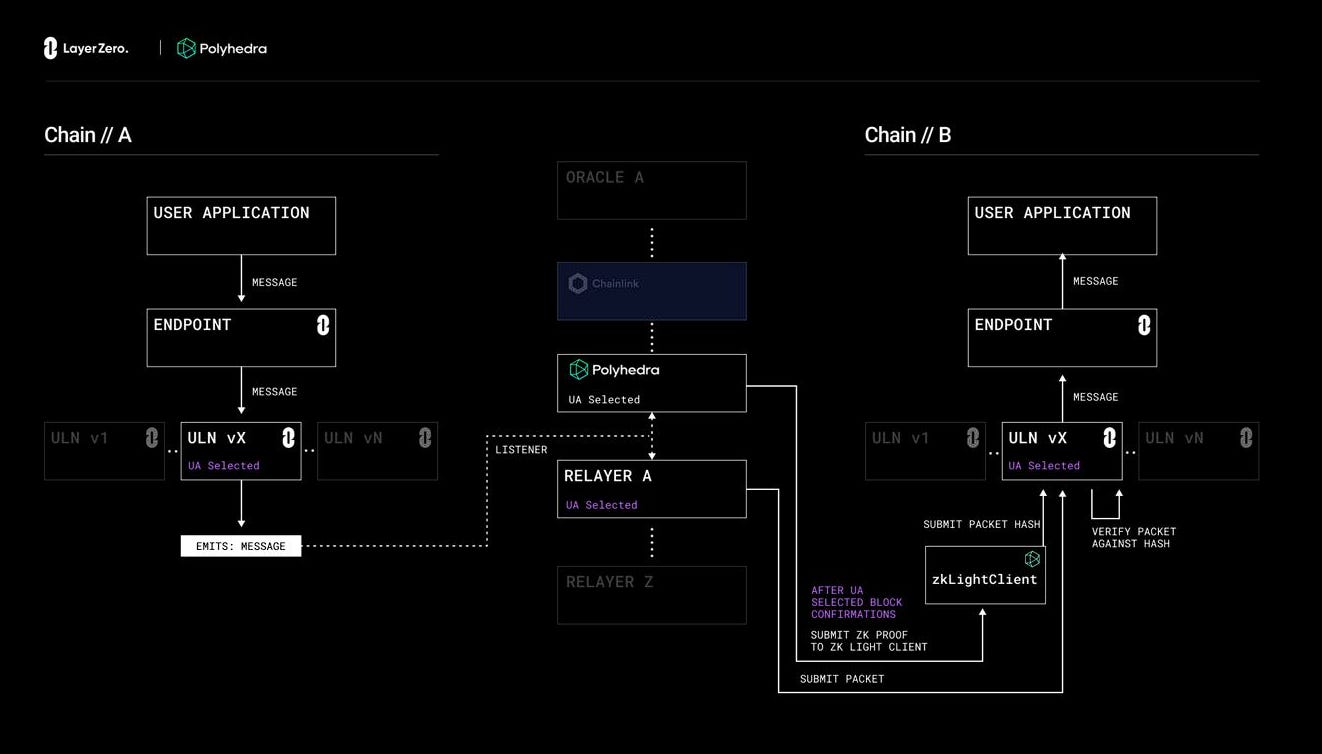
LayerZero’s ULNv2 validation library relies on the participation of two parties: the Oracle and the Relayer, for transferring messages between on-chain endpoints. When LayerZero transmits a message from chain A to chain B, the message follows a path from the endpoint on chain A to the ULNv2 validation library. The ULNv2 library informs the Oracle and Relayer about the message and its intended destination chain. Subsequently, the Oracle forwards the packet hash to the endpoint on chain B, while the Relayer submits the packet for on-chain verification against the hash and delivers the message accordingly.
To enhance security within the LayerZero messaging protocol, on-chain light clients enable the validator set of the source chain to validate events occurring on their chain and share them with the destination chain. Alongside other libraries, these light clients provide an additional layer of security. On-chain transaction verification has been excessively costly, ranging from $50 million to $100 million per day for each pairwise connection to Ethereum, primarily due to the requirement of extensive transaction logs, which are essential for proof but not for the application itself.
Polyhedra’s zkLightClient technology, integrated with LayerZero, leverages the compression capabilities of ZKP technology, significantly reducing on-chain verification overhead and latency. By utilizing efficient ZKP protocols, the zkLightClient technology diminishes the need for extensive transaction verification on-chain. Moreover, it enables the batching of multiple transaction verifications into a single zero-knowledge proof, further enhancing efficiency.
zkLightClient Addresses
To use the Polyhedra zkLightClient with your LayerZero UserApplication, configure your app with the Oracle addresses below.
The LayerZero protocol facilitates the secure and reliable transmission of messages between different chains following a series of steps:
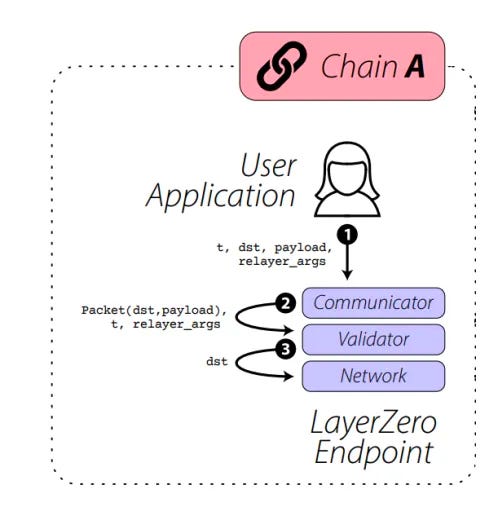

LayerZero achieves trustless valid delivery by leveraging the independence between the Oracle and Relayer components, rather than relying on trust. This design choice allows LayerZero to be efficient, lightweight, and resilient against collusion.
By providing trustless valid delivery, LayerZero offers an ideal solution for enabling cross-chain transactions without relying on intermediary entities or tokens. Its unique capability to guarantee trustless valid delivery positions LayerZero as the preferred method for cross-chain messaging, fostering user adoption and promoting seamless interoperability across different chains.
In LayerZero, messages are sent and received by LayerZero Endpoints, which handle the transmission, verification, and receipt of messages.
A LayerZero Endpoint is implemented as a set of smart contracts on each chain within the LayerZero network. Its core functionality is divided into three modules: Communication, Validation, and Network. These modules operate in a manner akin to a network stack, where messages flow down the stack on the sender side (Communicator to Validator to Network) and up the stack on the recipient side.
In addition to the core modules, LayerZero Endpoints can be extended using Libraries, which are auxiliary smart contracts specifying how communication should be handled for a particular chain. Each chain in the LayerZero network has its own associated Library, and every Endpoint includes a copy of all the Libraries.
The presence of Libraries on both ends enables communication between any two chains within the LayerZero network. This design ensures that LayerZero forms a fully-connected network, empowering it to facilitate transactions and interactions between any pair of nodes across different chains.
These Endpoints consist of two components: a collection of versioned messaging libraries, and a proxy to route messages to the correct library version. When a message arrives at an endpoint, the endpoint selects the User Application configured library version to handle the message. The endpoint keeps all message states across versions and this allows libraries to be easily upgraded for fixes or optimizations.
Running smart contracts on Layer 1 chains, particularly as the amount of stored data increases, can be cost-prohibitive. To ensure the practicality of LayerZero Endpoints, the design of a lightweight client has been prioritized. This approach allows for cost adaptability, making the LayerZero Endpoint feasible and efficient even on Layer 1 chains with high operational costs.
Previous approaches, such as Golden Gate, which employed trustless cross-chain validation through cross-chain state machine replication (SMR), incurred substantial expenses, often amounting to millions of dollars per day when deployed on popular Layer 1 chains like Ethereum.
To address this challenge, LayerZero has devised an optimized solution by designing the most lightweight client possible for LayerZero Endpoints. The key insight is that replicating and storing block headers within the client is unnecessary. Instead, the protocol leverages off-chain entities, specifically the Oracle and Relayer, to handle the fetching of cross-chain headers and transaction proofs. This delegation of tasks significantly reduces the resource requirements of LayerZero Endpoints, resulting in a more lightweight nature.
LayerZero serves as the much-needed common language or the TCP/IP of blockchains, enabling seamless communication across different blockchain platforms. It is an open-source, immutable messaging protocol designed to foster the development of omnichain, interoperable applications. As a protocol, it enables developers to effortlessly transmit arbitrary data, external function calls, and tokens across various blockchains while maintaining complete autonomy and control over their applications.

One of the notable features of LayerZero is its adaptability, allowing developers and protocol teams to fine-tune configuration parameters to meet their specific needs. Despite this flexibility, LayerZero has faced criticism regarding its default configuration for decentralized systems.
LayerZero stands out as the ‘TCP/IP of blockchains’, offering a crucial protocol for enabling seamless interoperability and communication across various blockchain platforms.
To reiterate, LayerZero is not a messaging standard or a L1 blockchain, it is a protocol that prioritizes immutability, censorship resistance, and permissionlessness, embedding these values into its core architecture.

The current state of blockchain networks is often fragmented and lacks native interoperability, making tasks like token bridging between chains cumbersome and risky. LayerZero Labs aims to simplify and secure this process.
The idea that each Layer 1 (L1) or Layer 2 (L2) blockchain should specialize in its strengths and interoperate with others aligns with the philosophy of LayerZero Labs. This perspective fosters a more integrated and efficient blockchain environment.
LayerZero Labs is building towards a future where blockchains are not isolated entities but nodes in a larger Omnichain network. In this network, the role of each blockchain is redefined from being a competitor to a complement, focusing on its strengths and contributing to a more robust collective ecosystem.
LayerZero was born as a messaging protocol instead of a bridge, eliminating the need for locking or wrapping tokens and aiming to unify liquidity across chains. The protocol went live on March 17, 2022, and since launch, it has delivered millions of messages over thousands of smart contracts, amounting to billions of dollars worth of assets across 40+ chains without suffering any vulnerability.

Chain A sends a message containing bytes to Chain B, and Chain B executes whatever instructions are contained in the bytes. For the case of a token transfer, this was materialized in the OFT (Omnichain Fungible Token) standard, which works by burning tokens on the source chain and sending a message that delivers a function call to ming the same number of tokens in the destination chain.
The protocol’s commitment to immutability, censorship resistance, and permissionlessness underpins its unique positioning in the market, differentiating it from other messaging standards or blockchains.
In its initial iteration, LayerZero introduced a suite of smart contracts known as “Endpoints,” providing a universal interaction interface for applications. These contracts are immutable but still allow for an append-only version of the validation library – since validation techniques will continue to evolve over time. Omnichian applications then interact with these endpoints by sending messages, which are simply arbitrary packets of data.

All of this workflow is orchestrated by two off-chain components: an oracle and a relayer. Oracles and relayers are entirely permissionless infrastructure that anybody can run and own without relying on any external party. They listen for events that happen on chain A, then hash those messages and pass them onto chain B, which verifies and executes the arbitrary message (it can be an asset transfer, a state mutation, a function invocation…).

Since the project’s inception, the thesis has been for the protocol to remain completely agnostic as to what the topology of oracles and relayers looks like – anybody can come in and run that infrastructure.

It’s important to note that LayerZero doesn’t fit into the traditional categories of centralized or decentralized; rather, it serves as a “build your own cross-chain infrastructure” sandbox. The emphasis is on permissionless customization, enabling users to configure the protocol according to their requirements. This versatility extends to aspects like security, oracles, block confirmations, and messaging libraries, all of which can be tailored to suit specific use cases.
The protocol’s ability to handle arbitrary data transmission and function calls across blockchains, while maintaining autonomy for applications, is what makes it possible to address the issue of liquidity fragmentation across chains.
An analogy can be made with TCP/IP, which is a set of rules that defines how two computers address each other and send data to each other. This set of rules is called a protocol.

In the past, there was no need for a common protocol, since it was not important for computers to communicate with each other. However, as computers became networked, the need arose for computers to agree on certain protocols. Hence, TCP/IP was conceptualized as a set of protocols that enable communication between computers. This is exactly what LayerZero is aiming to build in order to enable interoperability across chains.
As the protocol evolves into V2, it retains these core principles while introducing a decoupling of security and liveness, which still insists on message verification in the order of receipt, thus preserving the foundational properties of the system’s censorship-resistant nature.
LayerZero V2 achieves a fully connected mesh network by creating an infrastructure that enables every blockchain in the network to directly communicate with every other blockchain. This is a significant advancement in blockchain interoperability, as it allows for seamless interaction across different chains without the need for intermediary steps or bridges.

For this purpose, LayerZero employs a modular security model. This model allows for the immutable implementation of security, which can be extended to support new features and verification algorithms. It divides security into intrinsic and extrinsic components, with intrinsic security ensuring lossless, exactly-once, and eventual delivery of packets.
By addressing the interoperability challenge, LayerZero is not just a technical solution but a catalyst for a more cohesive landscape, potentially unlocking new possibilities for cross-chain applications.
The diagram below represents how the protocol integrity is divided into 4 categories: channel validity, channel liveness, data validity, and data liveness. The first two can be handled by the OMP (Omnichain Messaging Protocol), while the last two rely on the integrity of the underlying chain and cannot be secured by the OMP.

The intention of the design above is to ensure that intrinsic security works reliably and predictably over time, while the extrinsic security is modular and can be controlled by applications in order to continue evolving as technology advances. This allows applications to choose how much extrinsic security they require and how much they are willing to pay.
Similar to v1, an immutable contract called “endpoint” is deployed on each blockchain in the network. These endpoints are responsible for handling the core functions of the protocol, including packet transmission, ensuring censorship resistance, and exactly-once delivery.
The endpoints in LayerZero V2 serve as the fundamental nodes of the mesh network, establishing the primary interface between different blockchains. Each blockchain in the network has its own dedicated endpoint, and these endpoints function as gateways, facilitating the flow of information and transactions across the entire network.

The immutability of these endpoints is critical to the integrity and security of the mesh network, ensuring that once established, the core functionalities and security parameters cannot be altered maliciously or inadvertently.
The v2 approach is the commitment to redefine how blockchains can collaborate, moving from isolated systems to components of a broader interconnected network
Nevertheless, LayerZero V2 further enhances the capabilities of these endpoints through advanced features:



A Decentralized Verified Network (DVN) plays a vital role in verifying the integrity of data transmitted across the network. This network of verifiers operates in a decentralized manner, making the system resilient to single points of failure and ensuring reliable cross-chain communication.
Any party can be a DVN: L2 native bridges, oracles, third-party bridges, or other verification systems such as ZK light clients. For instance, examples of third-party adapters include Axelar, Chainlink’s CCIP, Polyhedra, Nethermind, Obol, Tapioca, etc.
This is a key feature, since it enables a verification model where application developers can, for example, plug in Wormhole or Axelar’s validator sets. This makes this design strictly superior to those validator sets alone.

Since applications are responsible for their own extrinsic security, they can also choose their own Executor. These are entities that are responsible for quoting prices and gas as well as handling all of the complexities associated with user transactions. In exchange for this service they will charge a small fee on top of the gas cost.
Even though LayerZero will run an optional Executor out of the box, applications have an incentive to compete on both price and service. Considering that Executors are much simpler to run than Relayers, it is likely to see an increasing level of competition.
The strategic separation of execution and security functions in LayerZero V2 enhances the protocol’s resilience and reliability, providing a more robust foundation for secure cross-chain communication.
More importantly, LayerZero v2 works in such a way that, once a message is verified, anyone can execute a transaction. Applications can also choose whether to execute them in order – which might be important for a DeFi app – or in a way such that they can optimize for throughput (i.e. for gaming applications). Also, if one Executor goes down, it can be swapped by a replacement to ensure that liveness is not compromised (this would not be the case in v1 if the Relayer went down).
This way, the protocol separates the execution of feature logic from the core verification process. This separation ensures that the addition or modification of features does not compromise the security of the message transmission.
The principles or responsibilities of an Omnichain Messaging Protocol (OMP) like LayerZero can be condensed into two primary requirements: intrinsic security and universal semantics.

“Intrinsic security can and should be universally secured based on first principles.
In contrast, optimal, trustless communication across blockchains is impossible, and the continuous advancement in verification algorithms and blockchain design necessitates extensibility and configurability of extrinsic security.
This is true even in special cases such as L1–L2 rollups; the possibility
of hard forks necessitates L2 contract upgradability, thus making the L2 contract owner a trusted entity.” – LayerZero v2 Whitepaper
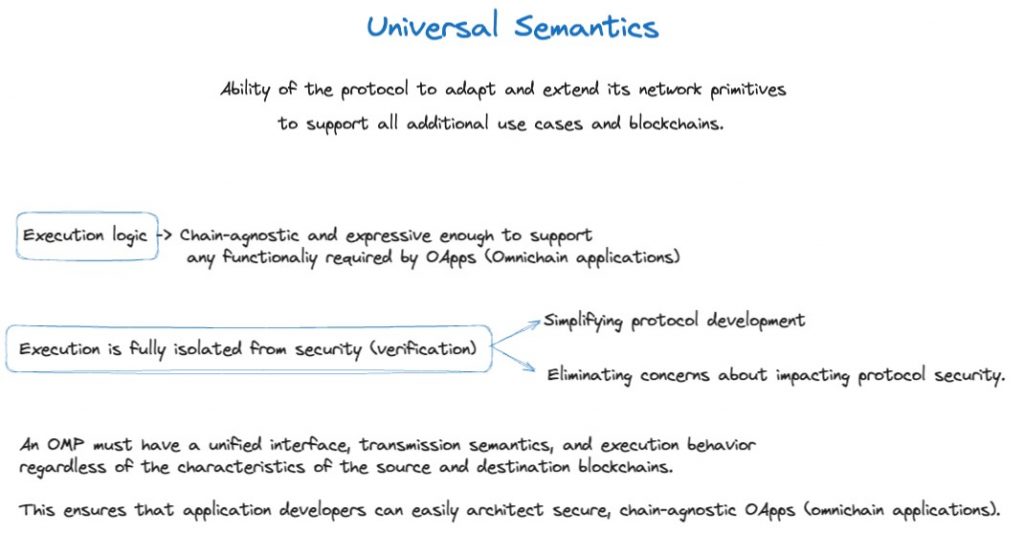
These principles address the fundamental deficiencies observed in existing cross-chain messaging services, such as monolithic security models and overspecialization, and provide a robust framework for secure and efficient omnichain interoperability.

LayerZero’s design as an OMP is grounded in these principles, ensuring it provides a scalable, secure, and universally applicable solution for blockchain interoperability.
The OApp security stack can be split into 4 components: immutable Endpoints for censorship resistance, append-only collection for on-chain verification modules, a permissionless set of Decentralized Verifier Networks (DVNs), and permissionless executors to execute feature logic in isolation to the cross-chain message verification context.


Together, these components form a two-layered architecture, where we differentiate between an execution and a verification layer.


Messages in LayerZero are composed of a payload and a path. These messages are serialized into packets before being transmitted across the mesh network.

Channel liveness (eventual delivery) is guaranteed through permissionless execution in conjunction with Security Stack reconfiguration, ensuring that even if DVNs experience faults or executors stop delivering messages, the OApp can regain liveness by reconfiguring its Security Stack or having another party deliver the packets.

By minimizing and standardizing interactions between components, LayerZero reduces potential software bugs. Because of its modular and configurable nature, it facilitates rapid prototyping and expansion to new blockchain networks.
LayerZero’s packet transmission process showcases its robust design for cross-chain communication, emphasizing security, orderliness, and resistance to censorship.
Each step, from the initial sending to the final execution, is carefully coordinated to maintain the integrity of the messages and the reliability of the network.
Configured DVNs independently verify the packet at the destination MessageLib. In the case of the Ultra Light Node, this typically involves storing the hash of the packet payload.
Once the required threshold of DVNs has verified the payload, a worker (like an executor, DVN operator, or user) commits the packet to the destination Endpoint.

The Endpoint ensures the payload verification aligns with the OApp’s configured Security Stack before committing it to the lossless channel.
An executor on the destination chain calls lzReceive to execute the logic of the Receiver OApp based on the packet’s content.
This step is designed to prevent censorship, with the system reverting if the channel cannot ensure lossless and exactly-once delivery.


LayerZero’s design is remarkably adaptable, allowing for a range of extended functionalities through features like Message Options and lzCompose. These features enhance the protocol’s ability to handle diverse execution requirements and cross-chain interactions.
LayerZero’s ability to synergize with various blockchain technologies, rather than competing with them, sets a new precedent in the interoperability space,
LayerZero does not adhere to a single standard format for serializing arguments into Message Options. This flexibility means that developers aren’t required to write specialized code for each MessageLib.
To facilitate backward compatibility and ease of use, LayerZero defines three standardized formats for Message Options.
Since all messages processed by an executor have already been verified by the verification layer, this setup ensures that executors can perform a wide range of actions without compromising the integrity of the message.

LayerZero introduces lzCompose, a standardized interface for cross-chain composition. This feature is significant, especially for unifying composition semantics across all blockchain types (EVM, MoveVM…). The main benefit is the universality of lzCompose, which allows for defining a single application architecture scalable to all existing and future blockchains.
When data is stored using lzCompose, the integrity and liveness of the data are “closed”. This means that any errors within the composed contracts only affect the closure, not the entire system. This isolation is particularly useful for managing potential attack surfaces like reentrancy, as it confines the impact of faults.
It is not possible for OApss to use the Message Options interface to extend the verification scope to include additional data. However, it can be used to detect and filter out verified-yet-malicious messages (e.g. buggy messages that would trigger OApp-level faults).
This is achieved with an off-chain application-level security mechanism called PreCrime, which provides an additional layer of application-specific packet filtering on top of the existing LayerZero protocol.
This allows subsets of peers within an OApp (which could be some or all of an OApp’s contracts) to enforce security invariants after simulating the result of packet delivery. These checks are based on predetermined criteria relevant to the OApp’s functionality and security needs.
The results of these invariant checks are collated by an off-chain worker, and if any peer reports a violation of the set invariants, the off-chain worker halts the delivery of the corresponding packet.
As an example, consider the scenario of a token bridge spanning 3 chains (Chain A, Chain B, Chain C) with an initial token distribution where mintA = 10, mintB = 10, and mintC = 10.
Suppose Chain A is compromised and attempts to illegitimately mint additional tokens on Chain B without locking corresponding assets.
Pre-Crime detects this discrepancy by checking the total minted tokens (∑mint) against the total locked liquidity (∑lock) across all chains.
Upon identifying the breach (where ∑mint would exceed ∑lock due to the unauthorized minting on Chain B), Pre-Crime can intervene to prevent this malicious action.

This way, after detecting the violation, the receiver can skip the compromised nonce using the skip function, thus averting potential damage or faults at the OApp level.
Finally, it is worth noting that PreCrime does not enhance the core protocol security of LayerZero, nor does it protect against data integrity issues caused by malicious DVNs or blockchain-level faults. Its primary role is to act as an additional safeguard at the application level.
LayerZero’s architecture is designed to ensure the immutability and continuous improvement of its components, providing a reliable and adaptable framework for user applications (UAs).
The LayerZero Endpoint serves as the sole interface for UAs, allowing them to configure the Messaging Library used for sending and receiving verified messages. This configuration guarantees the ordering of message delivery across all messaging libraries.
One of the key aspects of LayerZero’s architecture is the perpetuity of Messaging Libraries. Once deployed, they remain in service indefinitely. No entity, including the LayerZero Labs multi-sig, has the power to de-register or change the configuration of a UA’s Messaging Library. This ensures the uninterrupted flow of messaging for UAs, providing stability and reliability.
LayerZero has the flexibility to deploy new Messaging Libraries that offer enhanced security and performance optimizations. For example, more efficient proof technologies can be integrated into new versions. Importantly, this evolution does not impact the UA interface, allowing for seamless migration to newer versions.
Multiple applications can be built on LayerZero’s infrastructure. Below you can find some examples of applications that can use LayerZero to implement cross-chain transactions:
Omnichain Fungible Tokens (OFTs) are tokens that follow a fungible token standard developed by LayerZero for cross-chain interoperability. Unlike traditional token transfer methods that rely on bridging and wrapping tokens, OFTs provide true composability across integrated blockchains within the LayerZero network.
With OFTs, tokens can be transferred directly between any integrated chain and can be used in decentralized applications (dApps) on those chains. This is made possible through the established contract-to-contract communication protocol of LayerZero. The process involves burning an OFT token on one chain, presenting the receipt to another chain, and minting an equivalent number of tokens there. This ensures a consistent token supply regardless of the chain on which the tokens reside.
The primary objective of OFTs is to create a seamless DeFi (Decentralized Finance) experience where users no longer need to worry about the specific blockchain they are using. All tokens, applications, and protocols can interact seamlessly, providing a more efficient and user-friendly DeFi ecosystem. This interoperability can be a significant boost for users, eliminating the need for multiple bridges, reducing costs, and enabling greater access to liquidity.
There are two versions of OFTs: OFT (v1) and OFTV2, each with specific use cases and differences:
The main difference between OFT (v1) and OFTV2 lies in their compatibility with non-EVM chains. Non-EVM chains, such as Aptos or Solana, use Uint64 to represent token balances. OFTV2 accommodates this difference by utilizing Shared Decimals for value transfers, which normalizes the data type disparity. It is suggested to choose a smaller shared decimal point for all chains to allow for a larger token balance. For instance, if the decimal point is set to 18, the maximum number of tokens would be limited to approximately 18 * 10^18 tokens due to the constraint imposed by uint64.max.
Additionally, OFTV2 is recommended to be used with no more than 10 shared decimals. This limitation is in place to ensure efficient and effective token operations across chains.
OFTs address three obstacles currently hindering the full potential of multi-chain DeFi:
There are two types of ONFT predominant standards:

ColorTrace was introduced on November 14, 2023.
It is a value attribution mechanism that can enhance transparency and equitable reward distribution for yield-bearing stablecoins, regardless if the yield comes from off-chain RWAs or on-chain sources like staking rewards.
Current decentralized finance (DeFi) applications often rely on fungible tokens (e.g., stablecoins) to provide an easy-to-use, reliable, and trustworthy payment mechanism. However, there exists a key deficiency with current fungible tokens: once they are issued (minted), there is no practical onchain algorithm to keep track of the entity (minter) that minted them.
This makes it impossible to:
LayerZero formalized this dilemma as the fungible token coloring problem of “coloring” fungible tokens to associate each token to the entity that originally minted it, and presented a novel algorithm to solve this problem.
ColorTrace, is the first to solve the fungible token coloring problem in O(1) storage complexity. This is achieved by requiring all transfers to recolor tokens such that the receiver wallet balance and sent tokens are of the same color. In addition to solving the fungible token coloring problem in a single-chain context, they solve the additional economic and safety challenges to extend ColorTrace to support provably-safe crosschain token transfers. The safety of crosschain transactions is guaranteed by the delta-zero invariant, a single invariant which they use to formally prove the safety and validity of ColorTrace’s crosschain recoloring methods.
A vault on the primary chain governs the association of underlying value to onchain colored tokens and token contracts deployed to a collection of independent blockchains conduct transactions and periodically synchronize token recolorings to the vault. ColorTrace is divided into a coloring layer and synchronization layer. The coloring layer implements O(1) token transfers with predictable gas consumption for all user-facing operations, but introduces entropy into the system in the form of token recolorings and chain-local ∆ imbalances (nonzero ∆θ ).
This divergence in the system is resolved by the synchronization layer, which implements safe and globally consistent synchronization of recolorings to the vault. Both the coloring and synchronization layers are provably safe by ensuring the net error in the system is zero via the delta-zero invariant.
ColorTrace addresses the token coloring problem, which involves tracking the origin of tokens for fair burning and attributing the number of colored tokens minted by each minter in proportion to the global token supply.
Put together, this enables verified minters to mark their tokens and access rewards from on-chain reserves transparently and without disputes.
The implementation of ColorTrace goes beyond stablecoins, presenting a model for on-chain value tracking and equitable distribution that could revolutionize how value and rewards are attributed in decentralized networks.
The foundation of ColorTrace is “lossy coloring,” a solution for token coloring that serves as the basis for four algorithms: ColorFloat, ColorTrace, rho, and ColorAge. This is achieved in a highly efficient manner with O(1) complexity, avoiding the common scalability problems associated with traditional O(n) solutions.
Beyond stablecoins, ColorTrace’s on-chain value attribution can be applied to various use cases, such as on-chain referral programs and affiliate programs, fostering fairness and equity.
ColorTrace opens the potential for blockchain applications to integrate more deeply with fungible tokens and enables a more equitable Web3 ecosystem.

Verified USD, or $USDV, is developed as the first omnichain tokenized treasury-backed stablecoin by the Verified USD Foundation. Its primary goal is to provide a stablecoin solution that is natively interoperable across multiple blockchain networks, facilitating DeFi and CeFi rewards for its active circulation.

The problem to be solved is that much of the value of existing stablecoins is driven by market participants themselves, yet they are not fairly rewarded for it. Groups like Uniswap, Curve, Coinbase, and Binance have moved trillions of dollars of stablecoins and given immense utility to their underlying ecosystems and yet only one of those has ever been directly rewarded for it – Coinbase.
Circle entered into a custom agreement with Coinbase to share the yield of $USDC based on Coinbase’s contributions to the success of $USDC. For this, Coinbase currently earns almost $1B per year. However, more than $20B are in circulation, with the majority portion on EOAs. For the balance sitting in Uniswap, Curve, Coinbase, and Binance it’s easy to see how much each party has contributed, but for the more than $10B+ sitting in user wallets and EOAs it’s hard to know how much each group has contributed to that.
USDV’s design as an omnichain stablecoin not only provides a stable medium of exchange across multiple chains, but also exemplifies how traditional financial instruments like treasuries can be integrated on-chain to ensure a more fair attribution of yield.
The simple solution would be to create similar deals with all other major parties, but this is where the tricky part comes in. Imagine a world today where $24B of USDC sits in circulation, with the majority in EOAs. How much yield goes to each party? For the balance sitting in Uniswap, Curve, Coinbase, and Binance it’s easy to see how much each party has contributed, but for the more than $10B+ sitting in user wallets and EOAs it’s hard to know how much each group has contributed to that.

This is where Colortrace comes in to solve the problem of on-chain value attribution. It unlocks the ability for each entity to receive pro-rata attribution for the value they have created for the underlying ecosystem.
In the case of $USDV, this means that each token an entity has minted into circulation will be marked with their color and be attributed to them until it is redeemed for the underlying asset.
$USDV utilizes ColorTrace, which allows for the distribution of rewards from stablecoin underlying assets, redirecting value generation back to the ecosystem and enabling protocols to claim ownership of their success. Each bill is equally spendable and yet you know unique characteristics about each based on their markings, such as who held them before, where they were printed, etc.

$USDV initially backs its value with Matrixport’s Short-term Treasury Bill Token (STBT), a tokenized T-bill with maturities within 6 months and reverse repurchase agreements (Repo) subject to daily rebasing to maintain a value of 1 USD. It also provides transparency through Chainlink’s Proof-of-Reserve statements, giving users direct on-chain visibility into circulation and issuance.

$USDV is also integrated with LayerZero’s Omnichain Fungible Tokens (OFT) Standard, a widely adopted standard designed for seamless operation across multiple blockchain networks.

The motivation behind building LayerZero stems from the fragmentation caused by the diverse range of blockchain platforms and the subsequent isolation of their ecosystems. While the industry puts an emphasis on the topic of decentralization, transparency, and immutability, the growth of specialized chains has created a need for interoperability solutions. Up until now, users and developers have been forced to split their resources, time, and liquidity between separate chains, hindering adoption.
LayerZero addresses this limitation by introducing trustless omnichain interoperability. By enabling direct transactions across all chains, LayerZero allows users to consolidate fragmented liquidity and fully maximize the potential of multiple applications on different chains. As a protocol, the objective is to leverage the three pillars of decentralization, transparency, and immutability to provide a foundation for cross-chain interactions without the need for compromising trust. For that, LayerZero eliminates the reliance on centralized exchanges or cross-chain bridges, providing users with efficient and direct transfers.
Blockchain interoperability remains an evolving challenge as the diversity of chains continues to grow, further fragmenting the liquidity available across chains. LayerZero was conceptualized to be the first Omnichain Messaging Protocol (OMP) to achieve a fully-connected mesh network that scales across all blockchains and use cases.

Since the beginning, the expectation was that teams would want to run their own relay infrastructure and set up their custom oracle configuration with a provider of their choice. However, the job of the relayer is actually quite complex, as it must deal with 50+ chains, N2pathways for gas abstractions, 10s of billions RPC calls, 10s of millions of messages passed…
Even though in theory LayerZero was trustless and developers could plug in the Oracle and Relayer of their choice, the reality is that multiple times would end up relying on a default setup that required trust on entities like Chainlink, Polyhedra, Google Cloud, and LayerZero Labs itself.

Given all of the complexities associated with those operations, only a very small set of relayers were running, which was suboptimal to realize the protocol’s vision of becoming agnostic infrastructure.
Previously, in V1, relayers were responsible for both the security aspect—assuring the validity of messages on the destination chain—as well as executing the transaction, which created a dependency where the message could not be validated without the relayer’s execution function. This coupling could potentially cause issues with message delivery and verification order, which is critical for maintaining censorship resistance in governance-related transactions
The decoupling of security and liveness in LayerZero v2 provides greater control and reliability for both applications and users.
The transition to V2 introduces several key innovations, with a notable focus on enhancing security and flexibility. Version 2 brings a notable iteration by completely decoupling liveness (the execution component) from security, thereby eliminating associated risks from V1.

In order to achieve this, LayerZero V2 has been designed from the ground up to revolutionize the way developers handle generic data, function calls, and tokens across different blockchains. It introduces a clear separation between message verification and execution, providing developers with greater control over their application’s security configuration and independent execution.
One of the standout advancements in LayerZero V2 is the decoupling of liveness and security within the validation layer. This fundamental change enables V2 to establish security through a robust X of Y of N multisig framework, which also incorporates the concept of veto rights that applications can wield for additional safety measures. This strategic move empowers developers and protocol teams to configure security parameters more effectively, aligning with their specific requirements.
Any third-party validation network (Decentralized Verifier Network, or DVN), including validators, external messaging protocols, and native bridges, can now act as verifiers within this layer without being tied to execution. This framework, embedded within the protocol itself, simplifies the setup compared to V1, where setups with oracles were more complex.

Execution, which was previously managed by relayers, is now in the hands of end-users, who can execute transactions on-chain, ensuring that their actions—like casting votes—are registered without requiring intermediaries. This self-execution aspect enhances the permissionless nature of the transactions.
LayerZero plays the role of an universal language for blockchains, facilitating interoperability across the broad spectrum of diverse chains (EVMs, Solana, Move-based chains…)
This design allows for completely permissionless execution. As soon as the security portion is signed off, anyone can make sure that a transaction goes across. For instance, this provides a better UX when a third party executor intervenes (i.e. you are on Ethereum and have $ETH in your wallet but you want to bridge to Polygon and have someone abstract the complexity of the $MATIC requirement to pay for gas on the destination).

Oracles and relayers continue to play a crucial role as off-chain infrastructure, listening for events and transferring state or funds across chains; however, in V2, their role as infrastructure is decoupled from security validations, underlining the move towards a purer infrastructure model.
In addition to these security improvements, LayerZero V2 brings substantial enhancements in various aspects, including message throughput, programmability, and other contract-specific optimizations. These improvements collectively result in a more flexible, high-performing, and future-proof messaging protocol.
Existing decentralized exchanges (DEXs) like Multichain and THORChain conduct transfers on-chain, which helps alleviate the trust problem. However, these implementations often involve converting user tokens into protocol-specific tokens that traverse an intermediate consensus layer to achieve transaction consensus. While this intermediate consensus layer is typically implemented securely, it still requires users to trust a sidechain to facilitate token transfers. This additional overhead is deemed unnecessary.

The figure above provides an illustration of LayerZero’s functionality in the context of building an exchange.
LayerZero addresses the trust problem by enabling direct cross-chain transactions without relying on intermediaries or compromising the fundamental trustlessness of blockchain technology. LayerZero’s communication primitive, termed “valid delivery,” ensures that a message (m) is delivered if and only if the corresponding transaction (tA) on Chain A is committed and valid. This is achieved through the collaboration of two independent entities: an Oracle that provides the block header and a Relayer that provides the transaction proof associated with tA.
By combining these independent entities, LayerZero ensures that the transaction on the recipient chain (Chain B) is paired with a valid and committed transaction on the sender chain (Chain A), without involving any intermediary chains. This direct cross-chain communication protocol guarantees secure and trustless transactions between chains.
LayerZero operates through lightweight on-chain clients called LayerZero Endpoints. Each supported chain has its own LayerZero Endpoint, enabling cross-chain transactions with any other chain that also has a LayerZero Endpoint. This creates a fully connected network, allowing nodes on different chains to have direct connections with each other.
The ability to perform direct cross-chain transactions opens up new possibilities for large-scale applications that were previously infeasible. Examples include cross-chain decentralized exchanges, multi-chain yield aggregators, and cross-chain lending. LayerZero enables users to freely move liquidity between chains, consolidating liquidity pools and participating in various decentralized finance (DeFi) applications across different chains and ecosystems without relying on third-party systems or intermediate tokens.
LayerZero introduced a roadmap on December 15, 2023.
The roadmap details an upcoming V2 upgrade that maximizes network throughput and liveness, while making it easier for dApp developers to build through unified semantics and modular security.
With V2, app owners have complete control over their Security Stack with the ability to choose and combine third-party Decentralized Verifier Networks (DVNs). These are off-chain networks of verifiers that come to consensus and attest to the validity of messages. Any party can be a DVN- L2 native bridges, oracles, third party bridges, or other verification systems, such as ZK light clients.
V2 is currently live on testnets.
The sector outlook for cross-chain communication and messaging bridges is evolving rapidly. While the term “cross-chain bridge” has often been associated with token transfers, bridges can facilitate much more than simple token transfers between blockchains.
Arbitrary messaging bridges (AMBs) are emerging as a key component of the cross-chain ecosystem. These bridges enable the transfer of various types of data, including tokens, chain states, contract calls, NFTs, governance votes, and more, between different chains. This expanded functionality opens up new possibilities for cross-chain governance, token launches, gaming experiences, and other innovative applications.
In this sector, we can also find protocols like Multichain, Wormhole, Axelar, Hyperlane, deBridge, and Celer IM.
LayerZero is a promising player in the Arbitrary Message Bridge (AMB) sector. The technology’s key strengths lie in its simplicity, lightweight clients, and potential adoption from protocols building cross-chain applications. Its architecture is designed with developers in mind, requiring them to only implement two functions – send and receive – for any applications that can be written in Solidity, Rust, etc. This allows high-throughput chains to interact without constraint and without the need for a middleman.
One unique feature of LayerZero is its use of lightweight clients. Running smart contracts on Layer 1 can be costly; LayerZero mitigates this issue by exporting storage and fetching transaction data to off-chain entities called Oracles and Relayers. This makes LayerZero’s Ultra Light Node endpoints small, cost-effective, and quick to incorporate new chains.
Instead of relying on wrapped or intermediary assets, the technology behind LayerZero centers around “Endpoints” found on supported chains, which are implemented as a series of smart contracts allowing different domains to communicate. LayerZero relies on two off-chain entities, an Oracle and a Relayer, to pass messages between endpoints on different domains. Oracles relay generic data, such as block headers, while relayers fetch proof of specified transactions. This ensures LayerZero’s decentralization, as anyone can become a relayer. However, LayerZero’s security could be compromised if Oracles and Relayers were to collude and agree on invalid data.
The transaction process on LayerZero only requires source gas in a single call. A transaction is broken up into multiple parts by the Oracle and Relayer, facilitated by a LayerZero Endpoint. Once the information is verified as correct, the message is translated and executed on the destination chain.
In terms of security features, LayerZero has a high degree of assurance due to the independence of Oracles and Relayers. The probability of a block header and transaction proof matching without prior knowledge is low, making collusion and attacks expensive and less likely. Furthermore, LayerZero’s simple and effective design enables security tracing down to the chains where its Endpoints reside.
By design, LayerZero faces little to no competition, since it is an agnostic protocol that can grow in two ways:
Put together, this can create a positive feedback loop such that the more chains the protocol can support, the more appealing it is for apps to integrate with LayerZero.

Other interoperability protocols would fall into either the verification or execution category, but LayerZero embraces all of them by design, since v2 decouples liveness from execution. It is important to note that this does not mean that LayerZero created a messaging protocol by simply chaining together multiple cross-chain messaging systems. It is the opposite, since it leverages foundational invariants that make it possible to connect chains across different compatibility groups, such as EVM chains, MoveVM chains, Solana…
Another key point is the developer experience. LayerZero Labs offers tools and libraries for teams to choose the level of security they wish based on their own preferences and costs. The fact that there is no one-size-fits-all makes it very attractive for developers to embrace, since they can benefit from both the flexibility and extensibility of the LayerZero protocol.
It is worth noting that, while LayerZero Labs offers default configurations to make the lives of developers easier, they are just an option or alternative that can be used. Every other cross-chain protocol only has defaults, whereas LayerZero gives developers the voice to change their configuration and parameters. In other words, the worst case for LayerZero is the best case for any other messaging protocol.

Defaults do not have any effect whatsoever on how the protocol works. They simply provide a standard implementation to get started.
The comparative analysis of arbitrary messaging bridges (AMBs) focuses on evaluating their design trade-offs, core features, strengths, and weaknesses. The analysis is divided into five categories, each with several metrics embedded within:
1. Bridge Design – Theoretical Security: This category examines the theoretical security of each AMB by analyzing aspects such as the consensus mechanism, minimum number of validators required for collusion, censorship resistance, and permissionlessness of the validator set.
2. Practical Security Measures: Here, the focus is on the practical security measures implemented by each AMB. The metrics include the number of audits conducted for each AMB (more audits indicate better security), and the presence of open bug bounty programs with Immunefi, specifying the maximum reward for critical vulnerability findings.
3. Protocol History: This category assesses the history and track record of each AMB. It considers the time since the launch of the AMB to gauge its longevity and relevance. Additionally, any major hacks experienced by the AMB are highlighted, and the response of the team and their ability to recover from such incidents are evaluated.
4. Connectivity and Usage: This section examines the connectivity of each AMB by looking at the number of blockchains supported. The more blockchains an AMB supports, the more options it provides to projects looking for cross-chain compatibility.
5. Token Bridge’s Performance: This category focuses on the performance of the token bridges associated with each AMB. Metrics such as capital efficiency, total transaction count, total bridged volume, and the highest Total Value Locked (TVL) at the peak are considered to assess the success and performance of the token bridges.
| Messaging Bridge | Consensus Mechanism | Consensus Required for Message Censoring | Time Since Launch | Hacks |
| Axelar | Delegated PoS & Weighted Threshold Signature Scheme | 16 Validators, lower for chains with lesser validators | 17 months since Feb 2022 | Nil |
| Nomad | Optimistic | 1 Updated or Watcher
Only Update can cause downtime issues at a channel level |
18 months since Jan 2022 | $190M smart contract hack |
| Wormhole | Multisig | 7 Guardians | 23 months since Aug 2021 | $320M smart contract hack |
| LayerZero | Independent Oracle and Relayer | 1 Oracle or Relayer
Oracle and Relayer systems can be decentralized |
16 months since March 2022 | Nil |
| Celer IM | Specialized PoS or Optimistic-like model | 7 validators at current staked value | 15 months since April 2022 | Nil |
| anyCall | Secure Multi-Party Computation & Equally-Weighted Threshold Signature Scheme | 12 Validators | 15 months since April 2022 | $3M smart contract hack |
| Hyperlane | Delegated PoS & Sovereign Consensus | Validators can censor messages but stakes will be slashed for doing so | 12 months since July 2022 | Nil |
| deBridge | Threshold Signature Verification & Slashing and Delegated Staking | 5 | 17 months since Feb 2022 | Nil |
Connectivity of Networks:
LayerZero has a high potential for utility in various sectors. As a ground-level piece of infrastructure, it can be used by liquidity networks, multi-chain yield aggregators, multi-chain lending protocols, and other decentralized applications (dApps) for a wide array of crypto use cases. LayerZero Scan, a feature that ties cross-chain transactions together in a single database, offers users and developers easy access to transaction state, status, and timing information.
The AMB (Arbitrary Messaging Bridges) sector has already attracted major attention and funding from crypto giants such as Multicoin Capital, Binance Labs, A16z, and Sequoia among others. More specifically, LayerZero has already gained significant traction and has been adopted by major dApps like Stargate, Radiant, and Sushi. Besides, the protocol currently supports 11 different chains, including Ethereum, BNB Chain, Avalanche, and Polygon.
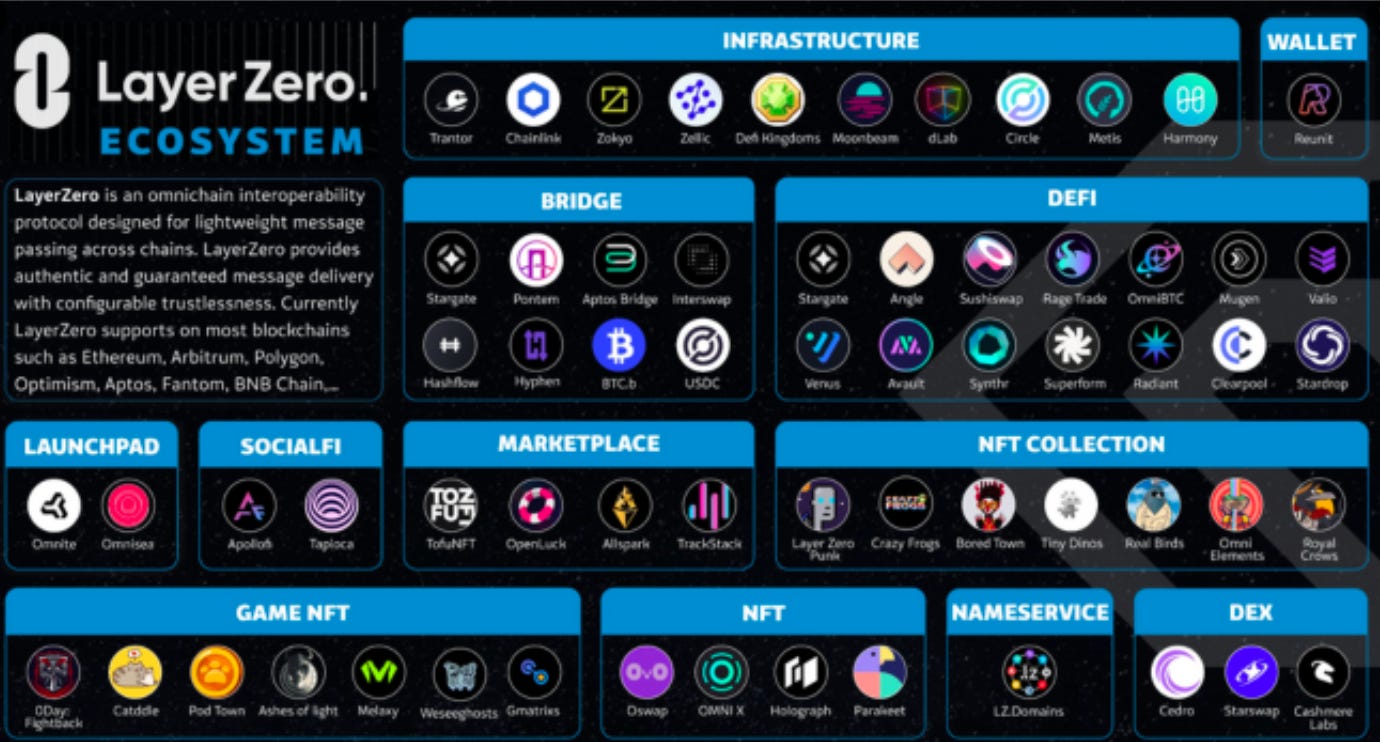
LayerZero currently supports a wide variety of chains, including Ethereum, BNB Chain, Arbitrum, Optimism, and many others.
A full list of the supported chains can be found here.
LayerZero’s business model relies on being the operator at the communication primitive level, facilitating diverse omnichain applications.
Revenue is derived from the Relayer, which takes a relayer fee from every message that is transmitted. The fee obtained depends on the native gas paid on the particular chain.
As the number of chains that are integrated by LayerZero grows, more messages are sent, leading to increased fees.
Sending a message requires paying native gas fees. The gas fee can be estimated by calling “estimateFees(“) to return a tuple containing the cross-chain message fee.
The “estimateFees()” function returns a dynamic fee based on Oracle and Relayer prices for the destination “chainId”, your “UserApplication” contract, and “payload parameters”.
In solidity, you can use the ILayerZeroEndpoint.sol interface to call the view function to get the send() fees.
Endpoint “estimateFees()”

The implementation of “lib.estimateFees()” illustrates how the total fee is calculated, which is the cumulative amount the oracle and relayer are collecting plus, potentially, a small protocol fee.
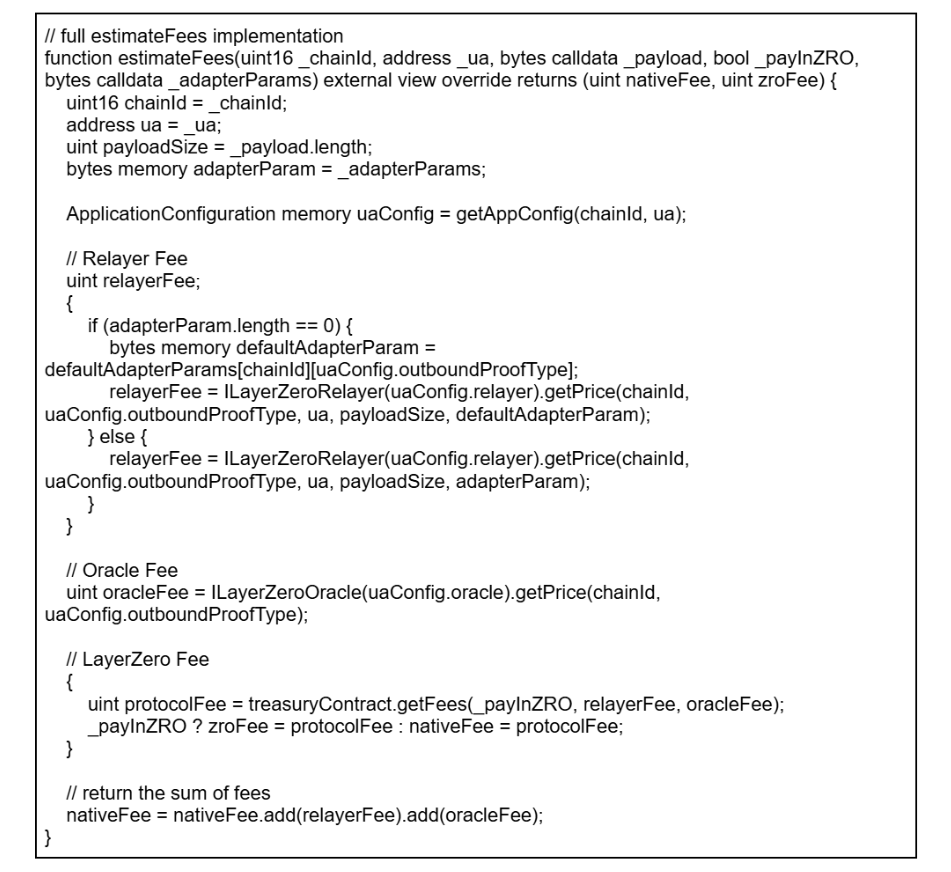
Offchain Fee Estimation Example:

The fee can be estimated by calling the Endpoint’s quote_fee() to get the fee tuple (native_fee (in coin), layerzero_fee (in coin)).

The LayerZero protocol’s native token, $ZRO, supports governance, incentivizes ecosystem growth, and offers fee accrual control. The total fixed supply is 1 billion tokens, distributed across four key categories:
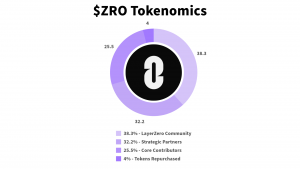
Community Allocation (38.3%): 383 million tokens reward early users, developers, and community contributors. This allocation includes:
Strategic Partners (32.2%): 322 million tokens with a three-year vesting period (one-year lock, then monthly unlocks) for investors and advisors.
Core Contributors (25.5%): 255 million tokens for LayerZero Labs team members, following the same vesting schedule as Strategic Partners.
Tokens Repurchased (4.0%): 40 million tokens pledged to the Community bucket by LayerZero Labs.
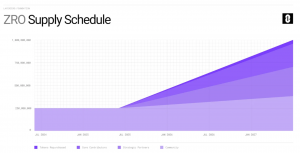
$ZRO holders govern protocol fees. Every six months, an on-chain referendum allows holders to vote on activating or deactivating LayerZero’s fee switch. If activated, the protocol may charge fees for verification and execution of cross-chain messages, burning fees collected via a Treasury Contract.
In terms of security, it is worth noting that if the block header provided by the Oracle and the transaction proof provided by the Relayer are both invalid but still match, then there is a collusion between the Oracle and Relayer. This is statistically improbable since both entities are meant to be independent. However, by design, the possibility of collusion is not fully eliminated, since each User Application can define its own Oracle and Relayer. Because of this, if a User Application chooses to go against this assumption, there is nothing that LayerZero can do to stop this collusion.
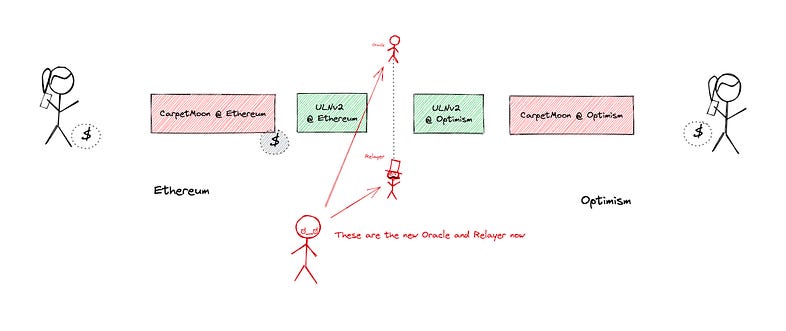
If the Oracle and the Relayer both fall under the control of a malicious actor, they would be able to perform actions such as tricking the protocol into believing that tokens have been burned on the source chain in order to withdraw on the destination chain even if no actions have taken place on the source chain.
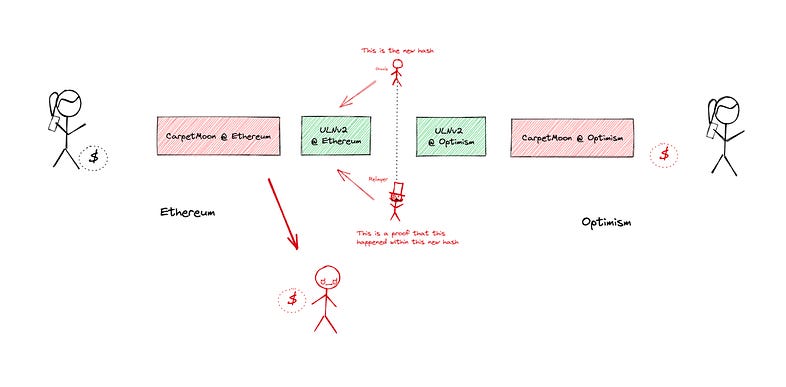
As a result, the security of LayerZero relies on the implicit assumption that the Oracle and the Relayer are independent entities and the protocol itself does not provide any security guarantees in that regard.
In practice, one can not make any assumptions about the security of the applications built using LayerZero — each application should be carefully reviewed to ensure the independence of their Oracle and Relayer setup.
LayerZero offers several security features to ensure the integrity and trustworthiness of its cross-chain messaging protocol:
LayerZero has commissioned more than 35 audits, some of the recent ones include:
LayerZero has a bug bounty program with Immunefi.
Rewards are distributed according to the impact of the vulnerability based on the Immunefi Vulnerability Severity Classification System V2.2. This is a simplified 5-level scale, with separate scales for websites/apps, smart contracts, and blockchains/DLTs, focusing on the impact of the vulnerability reported.
Bounties include:
It is highly recommended that User Applications implement the ILayerZeroApplicationConfig interface. This will provide them with the forseResumeReceive function, which, in the worst case, can allow the owner/multi-sig to unblock the queue of messages if something unexpected happens.
Reverting at the application level can be cumbersome and expensive. Instead, it is more efficient to design User Applications with Instant Finality Guaranteed such that if a transaction is accepted at the source, the transaction will be accepted at the remote. For example, Stargate achieves this with the Delta Algorithm, which is a credit management system that guarantees that if a swap is accepted at the source, then the destination must have enough assets to complete the swap.
User Applications should keep track of their own nonce by emitting events in order to correlate the send and receive transactions.
Developers are encouraged to do only one thing per message. The reason for that is because if the message was burned (misconfiguration, bad code…) the damage that is caused to the state will be minimal.
If the message execution fails at the destination, it is a good practice to store it for a future retry. This is because, from LayerZero’s perspective, the message has been delivered. Therefore, it is much cheaper and easier for the program to recover from the last state at the destination chain.
It is also recommended to store a hash of the message payload instead of storing the whole message since this is much cheaper.
If an application requires multiple message types to be sent across chains, User Applications should compute a rough gas estimate at the destination chain per each message type.
The reason for this is that the message might fail because of an out-of-gas exception at the destination if the application fails to instruct the relayer to put extra gas on contract execution.
Address sizes should be checked according to the source chain (e.g. address size == 20 bytes on EMV chains) to prevent attack vectors from unauthenticated contract calls.
Type-safe bytes codecs are recommended, limiting the use of custom codecs only when the user is comfortable with it and the application requires deep optimization.
The checklist below is intended to help prepare a project that integrates LayerZero for an external audit or Mainnet deployment.
LayerZero Lab’s LinkedIn indicates that there are 65 employees.
Some of the members include:
LazerZero had the following fundraises:
This glossary defines and explains many LayerZero concepts and terminology.